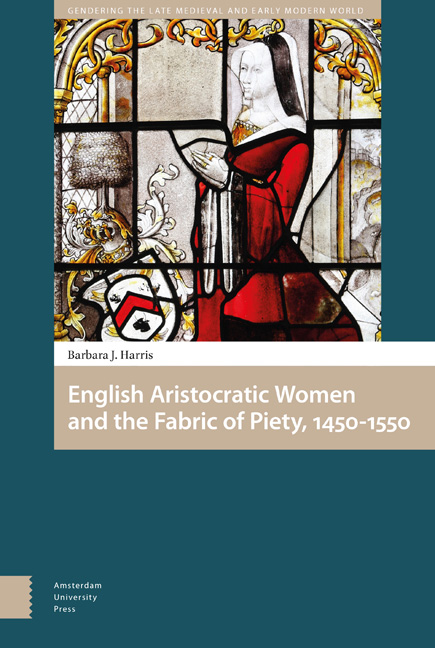Book contents
- Frontmatter
- Dedication
- Contents
- Abbreviations
- Illustrations
- Acknowledgements
- Preface
- Introduction
- 1 Tombs: Honoring the Dead
- 2 Chantries: The Quest for Perpetual Prayers
- 3 Building for the Congregation: Roofs, Aisles, and Stained Glass
- 4 Adorning the Liturgy: Luxury Fabrics and Chapel Plate
- 5 Almshouses and Schools: Prayers and Service to the Community
- 6 Defining Themselves
- 7 Epilogue: Destruction and Survival
- Conclusion
- Appendix 1 Patrons of the Fabric of the Church
- Appendix 2 Patrons of Tombs
- Appendix 3 Location of Tombs in Churches
- Appendix 4 Choice of Burial Companion
- Appendix 5 Women Who Commissioned Chantries
- Appendix 6 Commissions of Stained-Glass Windows
- Appendix 7 Additions or Major Repairs to Churches
- Appendix 8 Bequests of Vestments
- Appendix 9 Patrons of Almshouses or Schools
- Glossary
- Select Bibliography
- Archival Sources
- Index
2 - Chantries: The Quest for Perpetual Prayers
Published online by Cambridge University Press: 11 December 2020
- Frontmatter
- Dedication
- Contents
- Abbreviations
- Illustrations
- Acknowledgements
- Preface
- Introduction
- 1 Tombs: Honoring the Dead
- 2 Chantries: The Quest for Perpetual Prayers
- 3 Building for the Congregation: Roofs, Aisles, and Stained Glass
- 4 Adorning the Liturgy: Luxury Fabrics and Chapel Plate
- 5 Almshouses and Schools: Prayers and Service to the Community
- 6 Defining Themselves
- 7 Epilogue: Destruction and Survival
- Conclusion
- Appendix 1 Patrons of the Fabric of the Church
- Appendix 2 Patrons of Tombs
- Appendix 3 Location of Tombs in Churches
- Appendix 4 Choice of Burial Companion
- Appendix 5 Women Who Commissioned Chantries
- Appendix 6 Commissions of Stained-Glass Windows
- Appendix 7 Additions or Major Repairs to Churches
- Appendix 8 Bequests of Vestments
- Appendix 9 Patrons of Almshouses or Schools
- Glossary
- Select Bibliography
- Archival Sources
- Index
Summary
The bidding prayer on Sir Thomas Barnardiston's monument at Great Cotes, Lincolnshire, was an elaborate version of the simple request for prayers that appeared on virtually every tomb in pre-Reformation England. Nonetheless, it did not satisfy the Barnardistons’ desire for perpetual prayers. His widow therefore undertook to found a chantry, funded by land worth 7 marks per annum, which her husband had bequeathed for that purpose. A chantry was an endowment to support perpetual Masses for the soul of its founder and any other persons she named. Although prayers could be funded for a specific period of time, only perpetual chantries in the form of specially-built altars or chapels became part of the fabric of the churches in which they were located. These chantries, which were founded and/or built by aristocratic women, form the subject of this chapter.
Endowments for everlasting prayers first became popular in the thirteenth century. By 1300, they had become the “ultimate personal strategy for intercession.” From this time onward, founding chantries was the best possible provision for the afterlife, for those who could afford it. The efficacy of this strategy depended on the doctrine of Purgatory, which provided a coherent means of dealing with sin, and the increasing importance of the Mass as a means for reducing the amount of time a soul remained there. The more Masses that were said, the shorter the time.
Eamon Duffy has underscored the “overwhelming preoccupation” of the clergy and laity alike with shortening their stay in Purgatory and the “supreme efficacy of the Mass” in relieving its pains, while Jonathan Hughes has called the fourteenth and fifteenth centuries “the age of the perpetual chantry”. Although half of all chantries were founded between 1425 and 1500, Jonathan Finch has found that in Norfolk, the fate of the soul in Purgatory remained a major concern of worshippers until at least the beginning of the 1520s. Aristocratic women continued to establish chantries right through the period of Henrician reform.
This chapter focuses on chantries commissioned and constructed with the women's funds and according to their directions. The results of their endowments rivaled those of men of their class.
- Type
- Chapter
- Information
- Publisher: Amsterdam University PressPrint publication year: 2018

